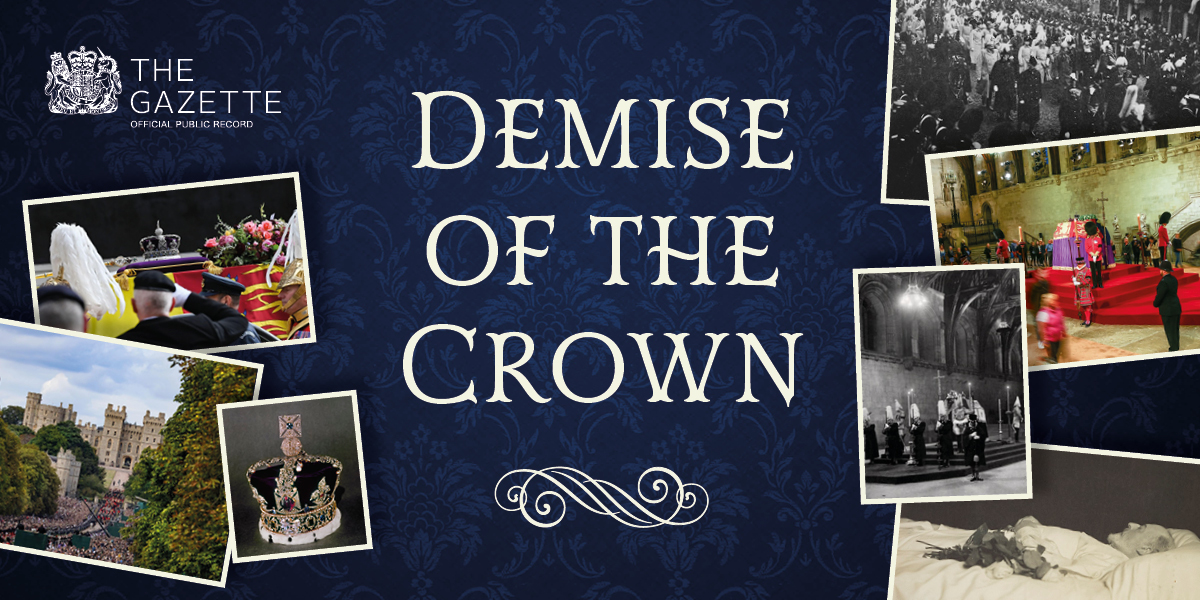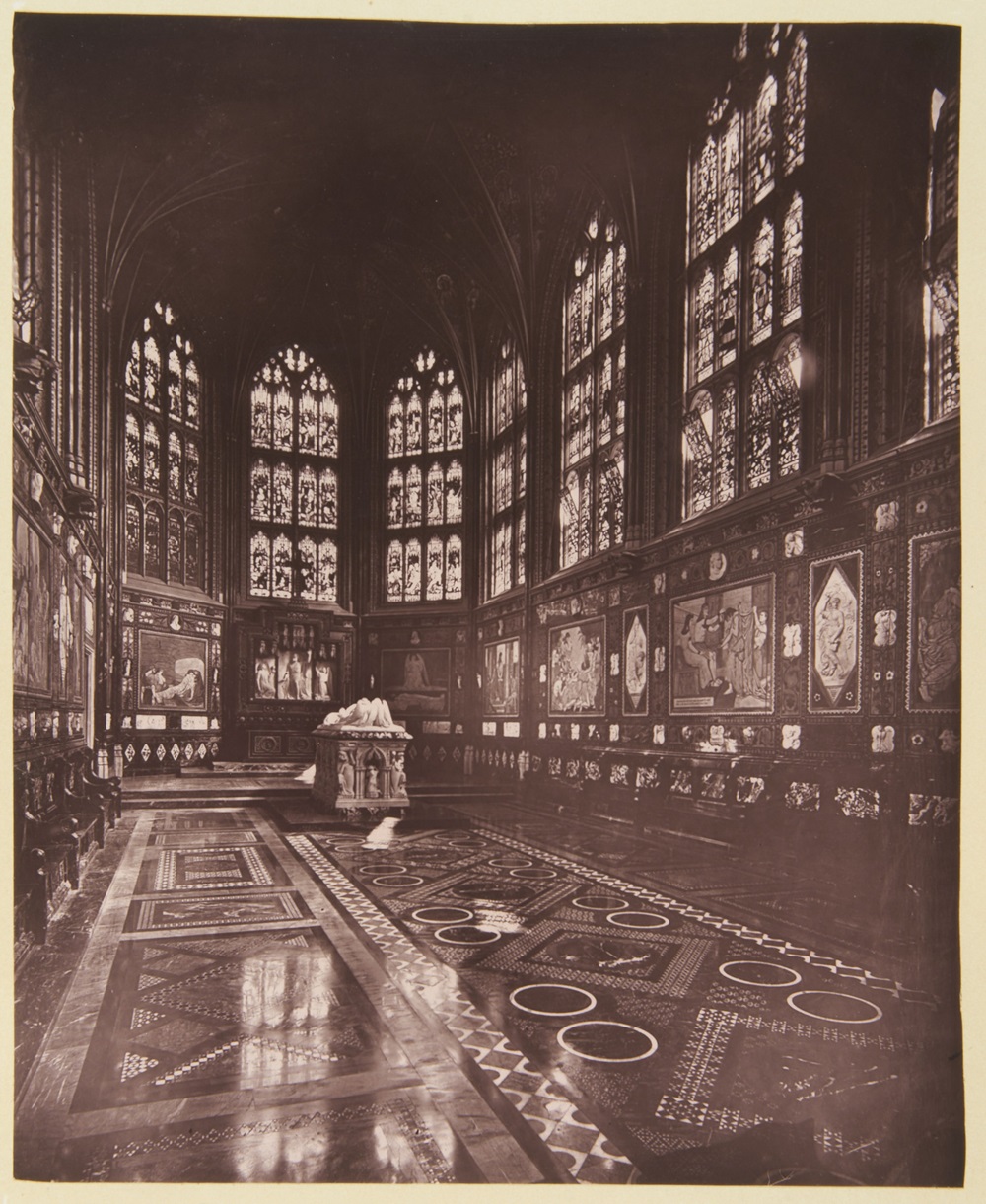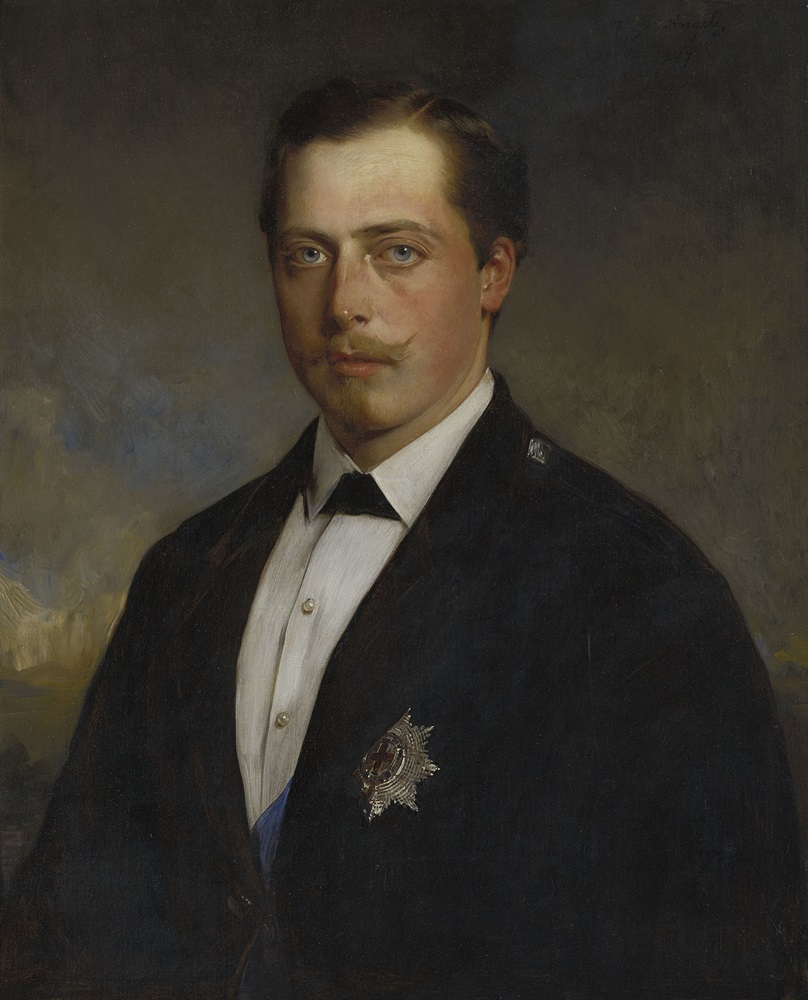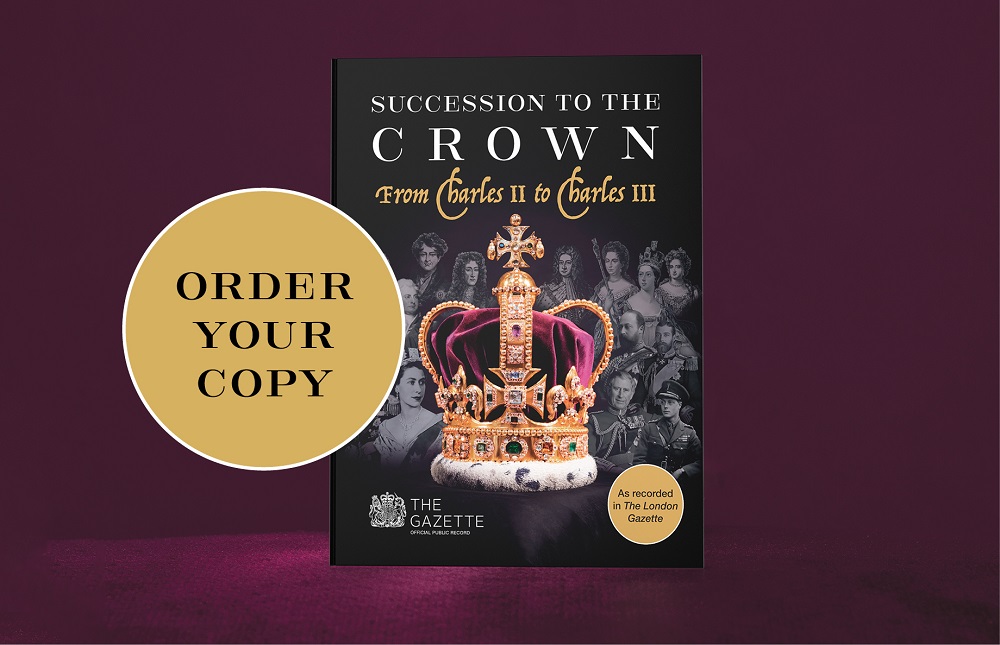Demise of the Crown: #15: Albert Memorial Chapel

As the official public record since 1665, The Gazette has been recording the deaths of monarchs for over three centuries. As part of our ‘Demise of the Crown’ series, historian Russell Malloch looks through the archives at The Gazette’s reporting of family demise events during the reign of Queen Victoria.

Albert Memorial
Queen Victoria and her family circle devoted their time and effort, as well as considerable resources, to creating shrines that helped them to grieve for personal losses. The Queen regularly visited the mausoleums she built at Frogmore in the early 1860s to house the remains of her husband and mother, as well as providing memorials to her Gloucester and Kent relatives in the Free Chapel of St George in Windsor Castle.
The Gazettes of the second half of Victoria’s reign continued to record a regular series of court mournings for departed family members, as well as marking the loss of a few persons of high standing, who were unlikely to merit a special memorial at Windsor.
To take the year 1881, for example, mourning notices were gazetted for the Queen’s cousins from Saxe-Coburg-Gotha (Gazette issue 25000) and Wurttemberg (Gazette issue 25034), and black dress periods were set for the Dowager Grand Duchess of Mecklenburg-Strelitz (Gazette issue 24922), and the Dowager Queen of Denmark (Gazette issue 24949). There were also notices about two heads of state who were assassinated during that year, Emperor Alexander of Russia (Gazette issue 24951), and James Garfield, the president of the United States of America (Gazette issue 25017).
Two ceremonials that were published during this period were of particular relevance to the Queen and to Windsor Castle, as they related to the demise of her son and grandson, and resulted in alterations being made to the Albert Memorial Chapel, the cenotaph to the Prince Consort, whose remains now lay at Frogmore.
Princess Alice
The Albert Memorial Chapel became the resting place of the Queen’s youngest son Leopold, the second of three of her children who died during her lifetime. The prince expired five years after The Gazette reported the loss of his older sister Alice, Grand Duchess of Hesse, who succumbed to diphtheria at Darmstadt on 14 December 1878, the dreaded anniversary of her father’s death.
The Gazette did not publish the ceremonial for the passing of the princess, which occurred only a few weeks after her four-year-old daughter Mary was lost to the same disease. Alice’s funeral was conducted according to the local religious rites in Germany, at a service attended by the Prince of Wales and Prince Leopold, while some relatives were absent because of the risk of infection. On the same day, the Queen was present at a special service that was delivered in the private chapel at Windsor by Gerald Wellesley, who had been the dean at the castle since 1854 (Gazette issue 21660).
The remains of mother and child lay in the family’s church until 1910, when they were transferred to the mausoleum her son constructed for his parents and siblings at Rosenhohe, near the grand ducal palace, in which one of the monuments, by the sculptor Joseph Boehm, showed Alice with her daughter in her arms.
The unusual step was taken to publish the letter the Queen composed at Osborne at Christmas 1878, which she sent to the home secretary. The Gazette (Gazette issue 24663) reported that the Queen was:
“anxious to take the earliest opportunity of expressing publicly her heartfelt thanks for the universal and most touching sympathy shown to her by all classes of her loyal and faithful subjects on the present occasion when it has pleased God to call away from this world her dearly-beloved daughter, the Princess Alice, Grand Duchess of Hesse. […]
Seventeen years ago, at this very time, when a similar bereavement crushed the Queen’s happiness, and this beloved and lamented daughter was her great comfort and support, the nation evinced the same touching sympathy, as well as when, in December, 1871, the Prince of Wales was at the point of death.
Such an exhibition of true and tender feeling will ever remain engraven on the Queen’s heart, and is the more to be valued at this moment of great distress in the country, which no one more deeply deplores than the Queen herself.”

Prince Leopold
Alice’s brother Leopold, by then the Duke of Albany, died at Cannes in the south of France in 1884 (Gazette issue 25334), and The Gazette outlined how his remains were transported to Cherbourg, then on to the royal yacht for the trip to Portsmouth, and finally by train to Berkshire. At Windsor a guard of honour was mounted by a unit of the Seaforth Highlanders, of which Leopold had been an honorary colonel since 1882 (Gazette issue 25080).
Periods of court and general mourning were applied. The Lord Chamberlain’s Office set the black dress code to run from March to May 1884; while the earl marshal expected the general population to put themselves into mourning for three weeks, and the Admiralty and War Office regulated the dress for its officers (Gazette issue 25335). As sometimes happened, Leopold’s mourning overlapped with another black dress order, as The Gazette had also noted that mourning would operate in May for the Dowager Empress Maria of Austria (Gazette issue 25350).
A bearer party from the Seaforths carried the Duke of Albany’s coffin, covered with the Union Jack, to a gun carriage drawn by eight horses, which brought his remains to his father’s cenotaph beside St George’s Chapel. There was an escort of the Royal Horse Guards, bands of the Grenadier, Coldstream and Scots Guards, and a party of Royal Horse Artillery. The Prince of Wales walked behind his brother’s coffin, with the Crown Prince of Germany (later Emperor William II) and other family members.
The Gazette reported the ceremonial on 5 April 1884 (Gazette issue 25340), which included representatives of foreign monarchs, among them the German and Russian emperors, and the kings of Belgium, Denmark and Sweden. The account recorded the presence of Leopold’s insignia in the procession, and emblems that related to the titles Garter king of arms read at the end of the service: “knight of the Most Noble Order of the Garter, knight of the Most Ancient and Most Noble Order of the Thistle, knight grand commander of the Most Exalted Order of the Star of India, and knight grand cross of the Most Distinguished Order of St Michael and St George”.
Leopold’s pall bearers were his friends, among whom was Walter Campbell of Blythswood, who had the honour of performing the final act of casting earth on the coffin. The chief mourner was the Prince of Wales, and the casket was again borne by the Seaforth Highlanders, under Lieutenant Seymour Munro, while the regiment’s piper played “Lochaber no more” as the prince’s remains were lowered into the royal vault.
In May 1884 the Queen rewarded some of those who helped with her son’s funeral. She gave Lieutenant Munro a diamond pin with the initial “L” and a framed portrait of the Duke of Albany, while Sergeant Tonner of the Seaforths received a framed enamel photograph of the prince, and the eight bearers were presented with miniatures set in silver. This type of personal souvenir preceded the creation of the Royal Victorian Order in 1896, which provided Victoria and her successors with a convenient, and relatively inexpensive, form of personal gift that could be given after a family demise.
The Queen commissioned a tomb for her son, in which the sculptor Sir Joseph Boehm worked to a Scottish theme, as Leopold was shown dressed as an officer of the Seaforth Highlanders, with the star of the Thistle below that of the Garter (Gazette issue 25080). The Court Circular reported that in July 1885:
“the Queen, accompanied by their Royal Highnesses the Prince and Princess of Wales … entered the Albert Memorial Chapel, wither the coffin containing the remains of his late Royal Highness Prince Leopold (Duke of Albany) was removed on the 22d ult. from the royal vault and placed in their final resting-place in a marble sarcophagus, on which is placed a recumbent statue of the prince by Mr Boehm. A short service, consisting of prayer and a few verses of scripture and two hymns, was held in the chapel. The service was conducted by the dean of Windsor. Some of the friends of the duke, and members of his Royal Highness’s as well as of Her Majesty’s household, besides some of the royal servants, were present.”
One commentator described this service as “one of those elaborate and lugubrious mourning ceremonies in which the Queen particularly delights”, in a chapel she had converted into “one of the most sumptuous sanctuaries in Europe.”
More was to come, as the Queen placed a white marble medallion of Leopold’s effigy, within a wreath of oak leaves and thistles, in St Mildred’s Church at Whippingham on the Isle of Wight, where a series of memorials were later erected after the death of Leopold’s brother-in-law, Prince Henry of Battenberg.
Prince Alfred
The third and last of Victoria’s children to die before her was Alfred, Duke of Edinburgh, who had a naval career and was promoted to the rank of admiral of the fleet only a few months before he became the Reigning Duke of Saxe-Coburg-Gotha.
The Victorian Gazette reported periods of mourning for Alfred’s predecessors as reigning duke. The first was for his paternal grandfather, Ernest I, whose sister married the Duke of Kent and was the mother of Queen Victoria, and whose brother married Princess Charlotte of Wales, and later became King Leopold of the Belgians. Duke Ernest died in 1844 (Gazette issue 20320), five years after his son Albert married the Queen, and the dukedom then passed to Albert’s brother, Ernest II, whose mourning notice was gazetted in 1893 (Gazette issue 26435).
The close connection between families led to several periods of black dress being worn at court in London, including those for Duke Ernest’s brother Ferdinand in 1851; and his nephews Augustus of Saxe-Coburg-Gotha in 1881, and Ferdinand, prince consort of Portugal, in 1885.
On Ernest II’s death, the German title passed to his nephew Alfred, Duke of Edinburgh, rather than to Alfred’s older brother, the Prince of Wales, who had renounced his rights. Alfred accepted the foreign inheritance and gave up his capacity to serve in the Royal Navy, but not his membership of the Privy Council. By the time he expired at Coburg in the summer of 1900, his son and heir had already died, and under a family arrangement the dukedom now devolved on his nephew Charles Edward, Duke of Albany, the son of Prince Leopold, whose effigy now graced the Albert Memorial Chapel.
The Gazette announced the mourning details for Prince Alfred, which ran from August to September 1900 (Gazette issue 27215), and appeared in the same edition that introduced the black dress regulations for the late King of Italy. The Gazette did not, however, publish the ceremonial for Alfred’s funeral in Germany, where his remains were laid to rest.

Succession to the Crown: From Charles II to Charles III
Succession to the Crown is essential reading for anyone with a keen interest in the British royal family and provides an excellent and trusted source of information for historians, researchers and academics alike. The book takes you on a journey exploring the coronations, honours and emblems of the British monarchy, from the demise of King Charles II in 1685, through to the accession of King Charles III, as recorded in The London Gazette.
Historian Russell Malloch tells the story of the Crown through trusted, factual information found in the UK's official public record. Learn about the traditions and ceremony engrained in successions right up to the demise of Queen Elizabeth II and the resulting proclamation and accession of King Charles III.
Available to order now from the TSO Shop.
About the author
Russell Malloch is a member of the Orders and Medals Research Society and an authority on British honours. He authored Succession to the Crown: From Charles II to Charles III, which explores the coronations, honours and emblems of the British monarchy.
See also
King Charles III and The Gazette
Gazette Firsts: The history of The Gazette and monarch funerals
Find out more
Succession to the Crown: - From Charles II to Charles III (TSO shop)
Images
The Gazette
Royal Collection Trust / © His Majesty King Charles III 2025
Royal Collection Trust / © His Majesty King Charles III 2025
The Gazette
Publication date
27 January 2025
Any opinion expressed in this article is that of the author and the author alone, and does not necessarily represent that of The Gazette.
